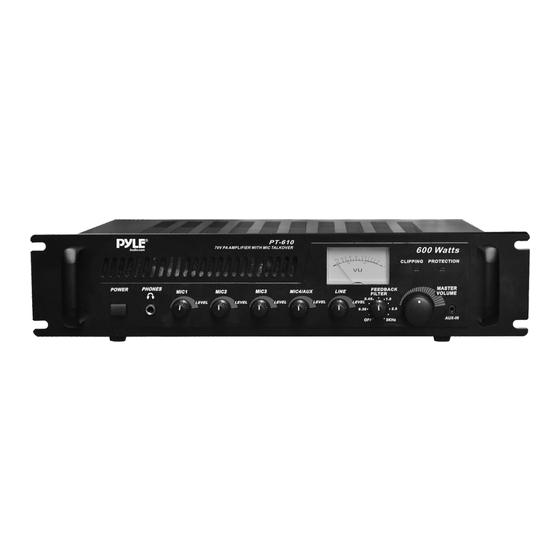Summary of Contents for PYLE Audio PT-610
- Page 1 PyleAudio.com PT-610 PT-610 PT-610 19'' Rack Mount 600 Watt Power Amplifier/ Mixer w/70V Output & Mic Talkover...
-
Page 2: Table Of Contents
Your new Pyle Pro PT-610 600 Watt P.A. Amplifier gives you the power and versatility you need in a professional sound system. The amplifier’s wide frequency response makes it suitable for amplifying music or vocal program material. It can be used for live bands, office paging systems, public announcement systems, or a variety of other installations. -
Page 3: Features And Contents
FEATURES AND CONTROLS FRONT PANEL REAR PANEL 10 11 15 16 17 1.Main Power On/Off Switch The amplifier is switched ON or OFF by using the switch. 2.Phone Jack Lets you connect a pair of stereo headphones for private listening or cueing (monitoring) sound prior to “airing”... - Page 4 8.Clip Circuit and Indicator This special circuitry protects the amplifier and speaker system from being damaged by overdriving power levels. Indicator lights remind the user to reduce the volume when amplifier output is excessive. 9.Power Meter Indicate the output signal level. 10.BYPASS/EQ Switch Sets the switch to the EQ position, you can connect an equalizer.
-
Page 5: Installation Guidelines
19. Voltage Switch The unit has a selectable input voltage from 115V/60Hz which is the standard in the USA and Canada. You can also switch the input voltage to 230V/50Hz for European operation. Please make sure the switch is in the proper position before operating, otherwise severe damage will result not covered by the warranty. -
Page 6: Connecting Microphones
“AUX” CD PLAYER Connecting and equalizer or external signal processor Connect the processor’s OUT to the amplifier’s IN, and the processor’s IN connector to the amplifier’s OUT. EQ OR MIXER Connecting microphone The MIC IN jacks permit you to connect up to 4 low impedance microphones. -
Page 7: Speaker Connections
Usually 18 gauge wire is adequate for lengths under 25 feet, while 16 gauge is used for greater lengths. Connector options The PT-610 offers several different connection points for speaker hookups. These include screw terminals, a 6.3mm jack, and a pair of banana plug connectors. -
Page 8: System 1: Single Speaker System
System 1: Single speaker system 1.Connect the speaker (-) terminal to the amplifier COMMON terminal. 2.Depending on the speaker being used, connect the speaker (+) terminal to the amplifier 4 Ohm, 8 Ohm or 16 Ohm amplifier terminal. THIS EXAMPL E SHOWS A 4 OHM SPEAKER System 2: Two (or more) speakers in series 1.Connect the LEFT SPEAKER (-) to the amplifier COMMON terminal. -
Page 9: System 3: Two Speakers In Parallel
System 3: Two (or more) speakers in parallel 1.Connect the LEFT SPEAKER (-) to the RIGHT SPEAKER (-). 2.Connect both the LEFT SPEAKERS (-) and RIGHT SPEAKER (-) to the amplifier COMMON terminal. 3.Connect the LEFT SPEAKER (+) to the RIGHT SPEAKER (+). 4.Connect both the LEFT SPEAKER (-) to the RIGHT SPEAKER (+) to the amplifier 4 Ohm, 8 Ohm or 16 Ohm terminal, depending on the TOTAL IMPEDANCE of the two speakers. - Page 10 Series/parallel variations Although the description above is for combining a series pair and a parallel pair in a parallel hookup, you may also elect to combine two series pairs in parallel hookup. Simply be sure you have properly calculated the total impedance, and attach the (+) speaker circuit wire to the proper amp terminal.
-
Page 11: System 5: Connecting Speakers With Transformers
System 5: Connecting speakers with transformers 1.Locate the input taps on your transformer. These taps are on one side of the transformer and are rated in watts: 10, 5, 2.3, 1.25 or 0.62. Usually, each speaker in a system uses the same wattage tap. Connect the selected tap to the amplifier 70V RMS terminal. -
Page 12: Using Headphones
Using headphones To listen privately, or to monitor sound sources, connect a pair of low impedance stereo headphones (not supplied) with a 6.35 mm plug into the PHONES jack on the amplifier front panel. Please listen safely. Follow these recommendations: Do not listen at extremely high volume levels. -
Page 13: Using The Power Meter
Using the power meter The meter pointer position indicates the amplifier output power. For ease of reading in dark environments, the meter is illuminated. Using the Master Volume control The Master Volume control increases or decreases output level gain. To obtain best performance with the least distortion, be sure to adjust the output level so that the meter’s pointer does not continually exceed the right extreme of the meter’s range. -
Page 14: About The Feedback Filter
About the feedback filter The PT610 features an anti-feedback filter, which can help to reduce or eliminate squealing or other noise caused by acoustic feedback. To engage this feature, after you turn on the amplifier, turn the front panel-mounted FEEDBACK control counterclockwise. This control decreases the feedback frequencies by up to 12DB. -
Page 15: Specifications
PT 610 Specifications Output Power at 100W , 1 k 2%, 8-O 200W Maximum Power , 8-O 600W Maximum Output, 4 THD at andpass ilter , 8-O , 1 k , w/b 0.35% MIC (phone/XLR jack) 0.20% 0.20% Line Frequency Response , +/- 3 d 75 Hz–20 kKz MIC (phone/XLR jack)






Need help?
Do you have a question about the PT-610 and is the answer not in the manual?
Questions and answers